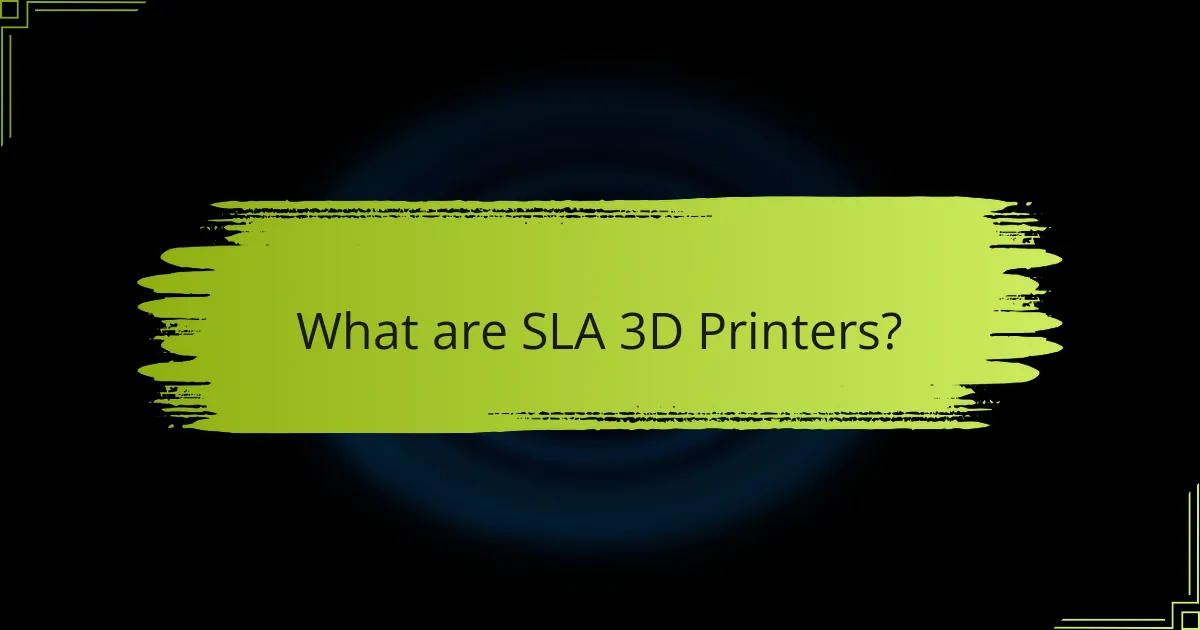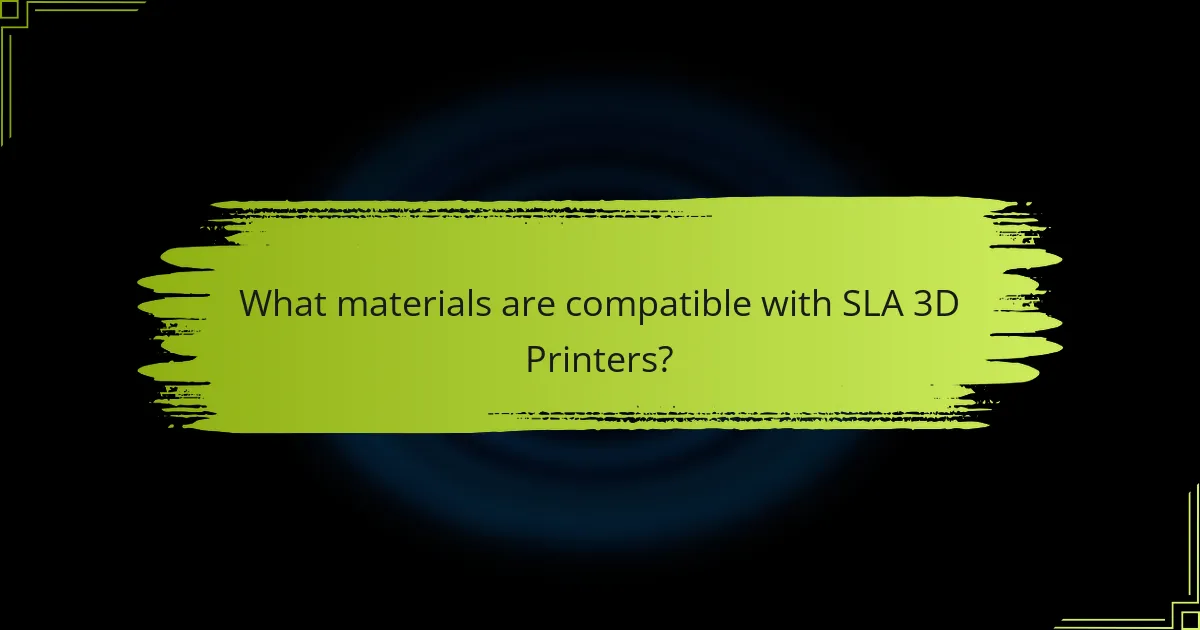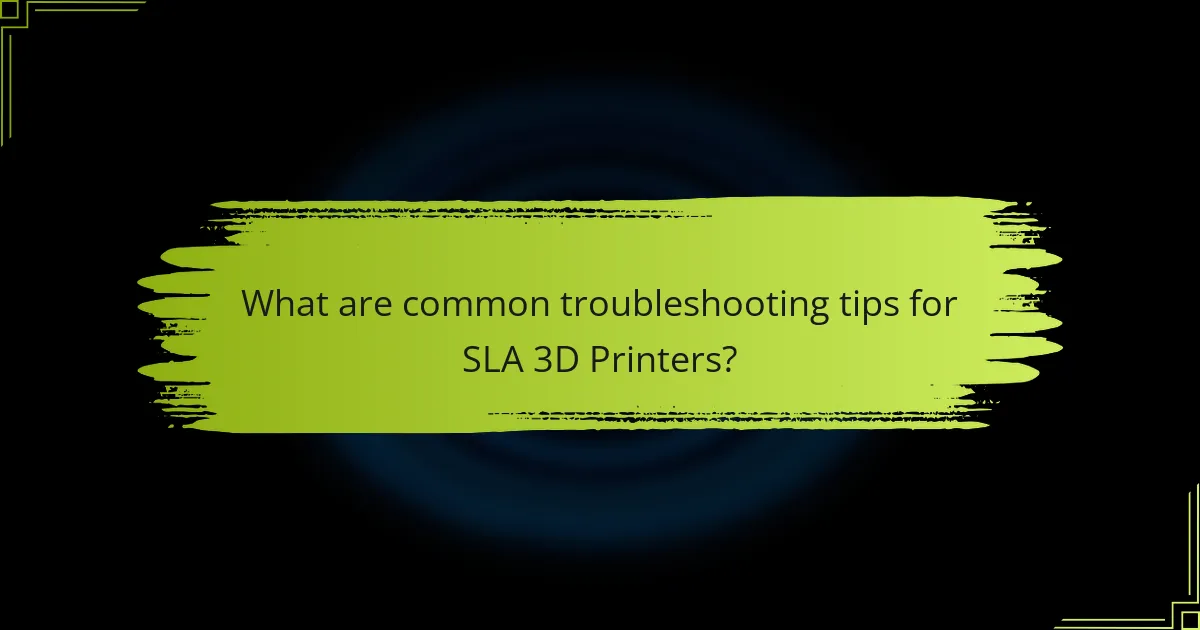
What are SLA 3D Printers?
SLA 3D printers are a type of additive manufacturing technology. They use a laser to cure liquid resin into solid objects layer by layer. This process is known as stereolithography. SLA printers are known for their high precision and detail. They are commonly used for prototyping and creating complex geometries. The technology allows for smooth surface finishes and intricate designs. SLA printers can produce parts with high dimensional accuracy. Their applications span various industries, including automotive, aerospace, and healthcare.
How do SLA 3D Printers operate?
SLA 3D printers operate by using a laser to cure liquid resin into solid objects. The process begins with a build platform submerged in a vat of photopolymer resin. A UV laser selectively targets and solidifies the resin layer by layer. Each layer is formed according to a digital 3D model. After a layer is cured, the build platform moves up to allow fresh resin to flow beneath it. This cycle repeats until the object is fully formed. SLA technology achieves high-resolution prints due to the precision of the laser. This method is widely used for creating detailed prototypes and complex geometries.
What technology underpins the functioning of SLA 3D Printers?
SLA 3D printers operate using stereolithography technology. This process utilizes a laser to cure liquid resin into solid plastic. The laser selectively solidifies layers of resin according to a digital model. Each layer is built on top of the previous one, creating a 3D object. This method allows for high precision and detail in the printed parts. Stereolithography was first developed in the 1980s by Chuck Hull. It remains one of the most accurate 3D printing technologies available today.
What are the key components of an SLA 3D Printer?
The key components of an SLA 3D printer include a resin tank, a build platform, a light source, and a control system. The resin tank holds the liquid photopolymer resin used in the printing process. The build platform is where the object is formed layer by layer. The light source, typically a UV laser or LCD screen, cures the resin to create solid layers. The control system manages the printer’s operations and coordinates the movement of the build platform. Each component plays a crucial role in the additive manufacturing process.
What are the key features of SLA 3D Printers?
SLA 3D printers utilize a laser to cure liquid resin into solid objects. They offer high precision and detail in printed models. The layer resolution can be as fine as 25 microns. SLA printers can produce complex geometries that other methods struggle with. They typically have a build volume ranging from small to medium sizes. The materials used are often photopolymer resins, which can vary in properties. SLA printers are known for their smooth surface finish. They require post-processing steps like washing and curing to achieve optimal results.
How does layer resolution affect the quality of prints?
Layer resolution directly impacts the quality of prints in SLA 3D printing. Higher layer resolution results in finer details and smoother surfaces. It allows for more precise reproduction of intricate designs. Conversely, lower layer resolution can lead to visible layer lines and reduced detail. A typical layer resolution for high-quality prints ranges from 25 to 100 microns. Research indicates that prints with a 25-micron resolution exhibit significantly improved surface finish compared to those at 200 microns. This enhancement is crucial for applications requiring high detail, such as jewelry or dental models. Therefore, optimizing layer resolution is essential for achieving desired print quality.
What types of light sources are used in SLA 3D Printers?
SLA 3D printers typically use UV light sources. The most common types of light sources are lasers and digital light projectors (DLP). Lasers provide precise point illumination, allowing for high-resolution prints. DLP systems utilize a light source to project an entire layer at once, increasing print speed. Both types effectively cure photopolymer resins, which are essential for the SLA printing process. The choice between laser and DLP affects the printer’s speed and resolution capabilities.
What build sizes are typically available for SLA 3D Printers?
SLA 3D printers typically offer build sizes ranging from small to large formats. Common small build sizes are around 120 x 68 x 175 mm. Medium-sized printers often have dimensions like 300 x 200 x 300 mm. Large SLA printers can reach build sizes of 600 x 600 x 600 mm or more. These variations allow users to select printers based on their project needs. The availability of different sizes accommodates diverse applications, from intricate models to larger prototypes.
What benefits do SLA 3D Printers provide?
SLA 3D printers provide high precision and detail in printed objects. They utilize a laser to cure liquid resin, enabling intricate designs. This technology results in smoother surfaces compared to other printing methods. SLA printers also support a variety of resin materials for diverse applications. They are ideal for creating prototypes, dental models, and jewelry. The layer thickness can be adjusted, enhancing customization. SLA printers typically have faster print speeds for small to medium-sized items. Their ability to produce complex geometries expands design possibilities.
How does SLA printing compare to other 3D printing technologies?
SLA printing offers high precision and smooth surface finishes compared to other 3D printing technologies like FDM and SLS. SLA uses a laser to cure liquid resin, allowing for intricate details and complex geometries. This method typically results in superior accuracy, with layer resolutions as fine as 25 microns. In contrast, FDM relies on melted filament, which can lead to visible layer lines and less detail. SLS, while effective for functional parts, often requires post-processing for surface smoothness. SLA’s materials also provide excellent mechanical properties and can be tailored for specific applications. Overall, SLA is preferred for applications requiring high detail, such as jewelry and dental models.
What advantages do SLA 3D Printers offer in terms of detail and finish?
SLA 3D printers offer superior detail and finish compared to other printing technologies. They utilize a laser to cure resin, allowing for intricate designs and fine features. The layer resolution can reach as low as 25 microns, enabling high precision in printed models. This technology minimizes visible layer lines, resulting in smoother surfaces. Moreover, SLA prints exhibit better dimensional accuracy, which is crucial for detailed applications. The ability to produce complex geometries is enhanced, making SLA ideal for prototypes and detailed designs. Additionally, post-processing can further improve the finish, allowing for polishing and painting. Overall, the advantages in detail and finish make SLA 3D printers a preferred choice in industries requiring high-quality outputs.
How can SLA 3D Printers enhance prototyping processes?
SLA 3D printers enhance prototyping processes by providing high precision and detail in models. They utilize laser technology to cure resin, resulting in smooth surfaces and intricate designs. The layer resolution can reach as fine as 25 microns. This level of detail is crucial for functional prototypes that require accurate dimensions. Additionally, SLA printers allow for rapid prototyping, significantly reducing lead times. Some models can produce parts in hours instead of days. This speed enables faster iterations and design modifications. Furthermore, SLA printers support a wide variety of materials, including flexible and durable resins. This versatility allows prototypes to better mimic the final product’s properties.

What materials are compatible with SLA 3D Printers?
SLA 3D printers are compatible with various photopolymer resins. These resins cure when exposed to specific wavelengths of light. Common types include standard resin, tough resin, flexible resin, and castable resin. Standard resin is used for general-purpose printing. Tough resin offers enhanced durability for functional parts. Flexible resin allows for bending and compression. Castable resin is designed for jewelry and dental applications. Each resin type has unique properties suited for different applications.
What types of resins are used in SLA printing?
SLA printing uses various types of resins. The main categories include standard resins, tough resins, flexible resins, and castable resins. Standard resins are ideal for general-purpose printing. Tough resins provide enhanced durability and impact resistance. Flexible resins allow for bending and stretching without breaking. Castable resins are designed for creating detailed molds for jewelry and dental applications. Each resin type has specific properties tailored for different applications. These properties make SLA printing versatile for various industries.
How do different resin types affect print performance?
Different resin types significantly affect print performance in SLA 3D printing. Each resin type has unique properties that influence curing time, detail resolution, and mechanical strength. For instance, standard resins typically offer good detail but may lack durability. Tough resins provide enhanced impact resistance, making them suitable for functional parts. Flexible resins allow for bending and stretching, which can be useful in applications requiring elasticity. High-temperature resins withstand elevated temperatures, maintaining structural integrity under stress. Additionally, specialized resins, like castable resins, are designed for specific applications such as jewelry making. The choice of resin directly impacts the final part’s quality, application suitability, and overall print success.
What special properties do engineering-grade resins offer?
Engineering-grade resins offer high durability, heat resistance, and excellent mechanical properties. These resins are specifically formulated for demanding applications. They can withstand extreme temperatures and mechanical stress. Engineering-grade resins also provide superior surface finish and detail. This makes them ideal for functional prototypes and end-use parts. Their chemical resistance is another notable property. It allows them to be used in various industrial environments. Overall, engineering-grade resins enhance the performance and reliability of 3D printed components.
How does material selection impact the final product?
Material selection significantly impacts the final product in SLA 3D printing. The chosen material influences mechanical properties, surface finish, and durability. Different resins offer varying levels of strength and flexibility. For instance, tough resins provide higher impact resistance compared to standard ones. Surface finish varies based on material viscosity and curing characteristics. High-quality resins result in smoother surfaces and finer details. Additionally, the material’s thermal properties affect how the product performs under heat. Studies show that specific materials can enhance the longevity of printed parts. Therefore, selecting the right material is crucial for achieving desired product attributes.
What factors should be considered when choosing resin for SLA printing?
When choosing resin for SLA printing, several factors should be considered. The first factor is the resin type, which includes standard, tough, flexible, and castable resins. Each type offers different mechanical properties suited for specific applications.
Next, consider the curing time, as it affects print speed and layer adhesion. Faster curing resins can significantly reduce overall printing time.
Another important factor is the viscosity of the resin. Lower viscosity resins tend to flow better and can produce finer details but may require specific printer settings.
The color and opacity of the resin can also impact the final appearance of the printed object. Some projects may require specific colors or translucency levels.
Additionally, evaluate the resin’s mechanical properties, such as tensile strength and impact resistance. These properties determine the durability and functionality of the printed parts.
Lastly, safety and handling characteristics are crucial. Some resins may emit harmful fumes or require special disposal methods. Always refer to the material safety data sheet (MSDS) for safety guidelines.
How do post-processing requirements vary by resin type?
Post-processing requirements vary significantly by resin type. Different resins have unique properties that influence their handling after printing. For instance, standard resins often require washing in isopropyl alcohol to remove uncured material. In contrast, flexible resins may need more extensive cleaning due to their rubber-like consistency. High-temperature resins can necessitate post-curing under UV light to achieve optimal strength. Additionally, specialty resins like dental or castable resins have specific protocols to ensure they meet industry standards. These variations are crucial for achieving the desired mechanical properties and surface finishes in the final printed parts.

What are common troubleshooting tips for SLA 3D Printers?
Common troubleshooting tips for SLA 3D printers include checking the resin level, ensuring proper calibration, and inspecting the build plate. Low resin levels can lead to incomplete prints. Calibration issues may cause misalignment, affecting print quality. A misaligned build plate can result in failed adhesion. Regularly clean the vat to prevent cured resin from interfering with prints. Monitor exposure times to avoid over or under-curing. Check the printer’s firmware for updates to improve performance. Lastly, ensure the printer is level to maintain consistent print quality.
How can users resolve common printing issues?
Users can resolve common printing issues by following a systematic troubleshooting approach. First, check the printer’s power and connections. Ensure the printer is plugged in and properly connected to the computer. Next, verify the printer settings in the software. Incorrect settings can lead to failed prints. Inspect the resin tank for proper levels and clarity. Low or contaminated resin can affect print quality. Clean the build plate and ensure it is leveled correctly. A dirty or unlevel build plate can cause adhesion problems. Update the printer’s firmware to the latest version. Outdated firmware can lead to compatibility issues. Finally, consult the printer’s manual for specific error codes and solutions. Following these steps can effectively address most common printing issues.
What steps can be taken to fix layer adhesion problems?
Increase the print temperature to enhance layer adhesion. Higher temperatures can improve the bonding between layers. Adjust the exposure time for each layer to ensure proper curing. Longer exposure times can help layers fuse better. Optimize the print speed to allow sufficient time for each layer to adhere. Slower speeds can lead to improved adhesion. Ensure the build platform is level and clean to promote consistent adhesion. A well-prepared surface can significantly affect layer bonding. Use appropriate resin formulations designed for better adhesion. Some resins are specifically engineered to enhance layer bonding. Regularly maintain and calibrate the printer to ensure optimal performance. Proper maintenance can prevent adhesion issues from arising.
How can print failures be minimized through calibration?
Calibration minimizes print failures by ensuring accurate alignment and settings of the printer. Proper calibration adjusts the build platform level, which is crucial for adhesion. It also fine-tunes the laser power and speed for optimal layer curing. Regular calibration checks help maintain consistent performance over time. According to a study by the University of California, calibrated printers show a 30% reduction in failed prints. This highlights the importance of calibration in achieving high-quality results in SLA 3D printing.
SLA 3D printers are advanced additive manufacturing devices that utilize stereolithography technology to create high-precision objects from liquid resin. This article explores the key features of SLA 3D printers, including their operation, essential components, and the benefits they offer, such as intricate design capabilities and smooth surface finishes. It also examines the various types of materials compatible with SLA printing, including standard, tough, flexible, and castable resins, and discusses the impact of resin selection on print performance. Additionally, troubleshooting tips and post-processing requirements for different resin types are provided to enhance user experience and print quality.